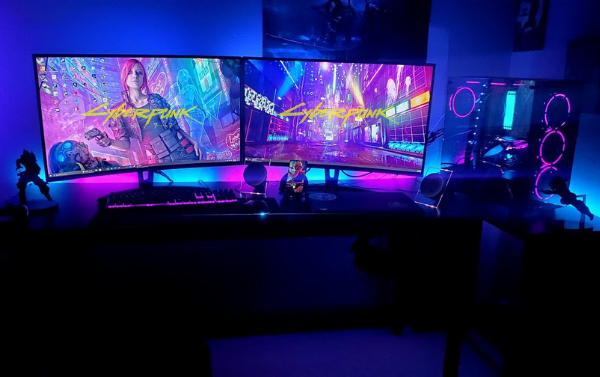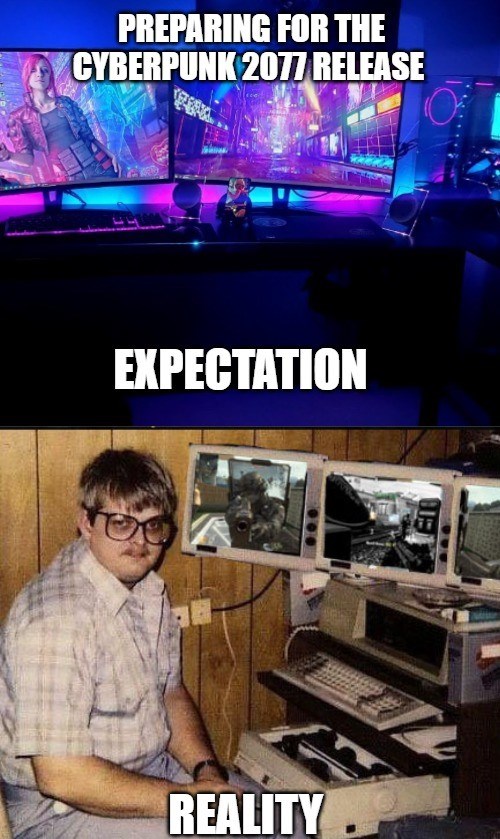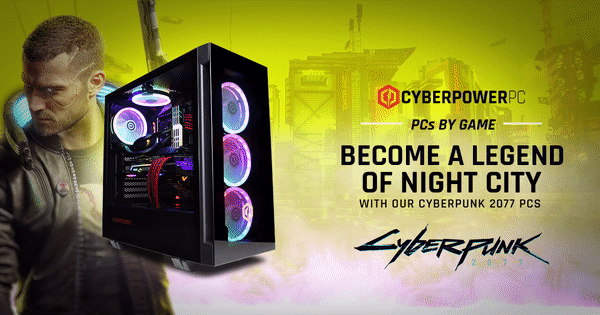
The biggest game of the year is about to land. It’s been delayed three times, and hyped immeasurably and everyone’s rightly very excited about it. Last week, we looked into the game and what it’s about. This time, we’ll consider what’s required to play it. So is this game on PC going to be worth the tech upgrade? Let’s take a look at what you need for Cyberpunk 2077 PC spec.
Is Cyberpunk 2077 coming to PC?
First things first. Yes, the game is coming to PC. Despite their successful forays into console gaming, CD Projekt Red maintain that the PC is their primary platform. As we’ll see, it’s on PC that quite a few of the game’s graphical niceties are going to find their fullest expression.
How many GB will Cyberpunk 2077 be?
Over recent years, games have been sucking up enormous amounts of hard drive space. When you consider that many gamers are combining larger SATA-based drives with smaller, nimbler, NVMe ones, this becomes a bit of a concern.
In the case of Cyberpunk 2077, we’re looking at a 70GB install. This actually makes it smaller than some games from years ago. With that said, we can expect this figure to climb as additional content is released.
Can My PC Run Cyberpunk 2077?
One of the advantages of owning a PC is that you can tweak the settings of any given game to match your machine. CD Projekt has unveiled some minimum and recommended specs that, upon first glance, appear a little on the optimistic side. These specs are all there to cater to gamers at 1080p, on high and low settings respectively.
If you have a GTX 1060 or an AMD Radeon R9 Fury, according to the developer, you should have a respectable experience. We should note, however, that they’re recommending the 6GB version of the 1060, not the 3GB version – which might suggest a hunger for video ram, especially at high resolutions. This is good news if you’re putting together a PC on a budget ahead of launch.
It’s not just your GPU that’s important, either: ‘…the game is both graphic and processor-intensive, so make sure these components meet or exceed the minimum requirements,’ warn the developer. If you’ve ever strolled into Novigrad on horseback and had your PC choke up at the volume of market traders it’s being asked to throw onto the screen, then you might appreciate the importance of a worthy CPU. Cyberpunk 2077 is mostly set in a built-up metropolis, so this challenge might be even more pressing.
We’ve written about how to match a PC to your favourite game in the past – many of the same principles will apply here. Naturally, if you enjoy the DLSS 2.0 and Ray Tracing features, you’ll need a compatible Ampere or Turing NVIDIA card. Speaking of which…

Ray Tracing features
If you’re fortunate enough to own an RTX card, then you’ll benefit from a suite of Ray Tracing features. Some of the terminology will be familiar to PC gamers who spend a lot of time tweaking settings (which, after all, is part of the joy of gaming on PC). But this is the first time that all four of these techniques will be pursued through Ray Tracing.
Ambient Occlusion
Since the original Crysis first landed back in 2007, ambient occlusion has made an enormous difference to the overall plausibility of the games we play. Put simply, it simulates the way that light behaves in the real world, making corners darker and prominent bits lighter. Try turning it off in your favourite game to see what a difference this makes. When the ambient occlusion is being generated by actually simulating beams of light, we get a much more accurate and lifelike effect.
Diffuse Illumination
In a game world, certain objects will emit light rather than just bouncing it. In most cases, we’re talking about the sun and the sky, but in Night City – festooned as it is with glowering neon signage – there are light sources just about everywhere you look. They’ll behave that much more gorgeously with the help of Ray Tracing.
Reflections
Ray-traced reflections were among the first to be incorporated into games, with Battlefield V. Of course, reflections might have been achieved using workarounds – but actually rendering objects which aren’t in the screen-space could be enormously difficult. With Ray Tracing, this is all done automatically – the reflective surface can be made as smooth or as rough as required. Take a look at some of the footage from the game and you’ll note the glossy effect that’s possible when rain-slick concrete is caught by sunlight at a certain time of day.
Shadows
NVIDIA has said that directional shadows based on the sun and moon have been added into the game; it’s here that Ray Tracing makes a real difference, as it allows the engine to account for factors like cloud cover and time of day.
This is an unprecedented amount of bells and whistles in a mainstream title, and it should ensure that the game looks absolutely stellar on a high-end machine. Time will tell whether this is the point at which Ray Tracing technology comes of age!
What about DLSS 2.0?
We’ve seen the game-changing effect that DLSS (deep-learning super sampling) can have on games like Control and Death Stranding. Feed-in a sufficiently high-resolution image and your video card will upscale the rest of the way. The AI can guess certain things, like text and straight lines, with a high degree of accuracy – even if it isn’t quite as sharp as rendering straight at the native resolution.
Given the performance improvement that’s possible using this technique, it’s arguably even more impressive than the Ray Tracing stuff; making a powerful case for a pre-Cyberpunk upgrade. The game will, after all, support the technology right out of the gate.
When does Cyberpunk 2077 come out for PC?
Last week, we told you that the game will launch simultaneously on Xbox, Playstation, PC and Google Stadia on November 19th. Well, CDPR has since made us look silly because it’s been delayed another three weeks, to December 10th. On the plus side, you have an extra three weeks to upgrade your system in time to really appreciate the detail gone into Cyberpunk 2077.
